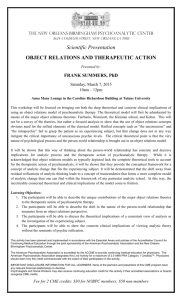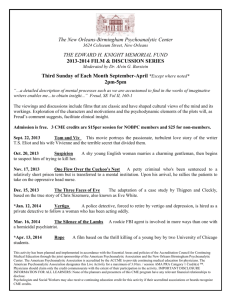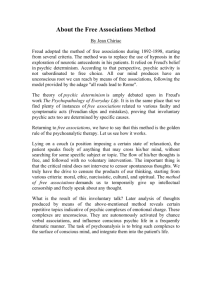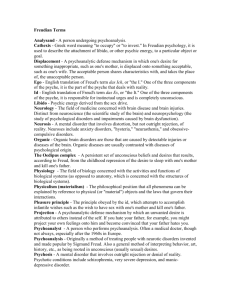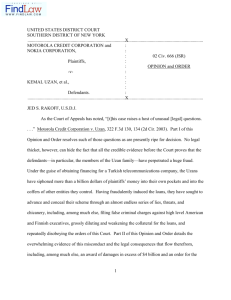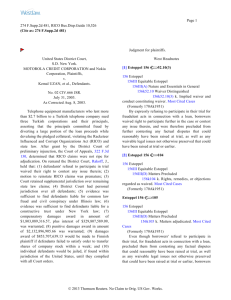The “actual” in psychoanalysis. Outline of a monograph to be
advertisement
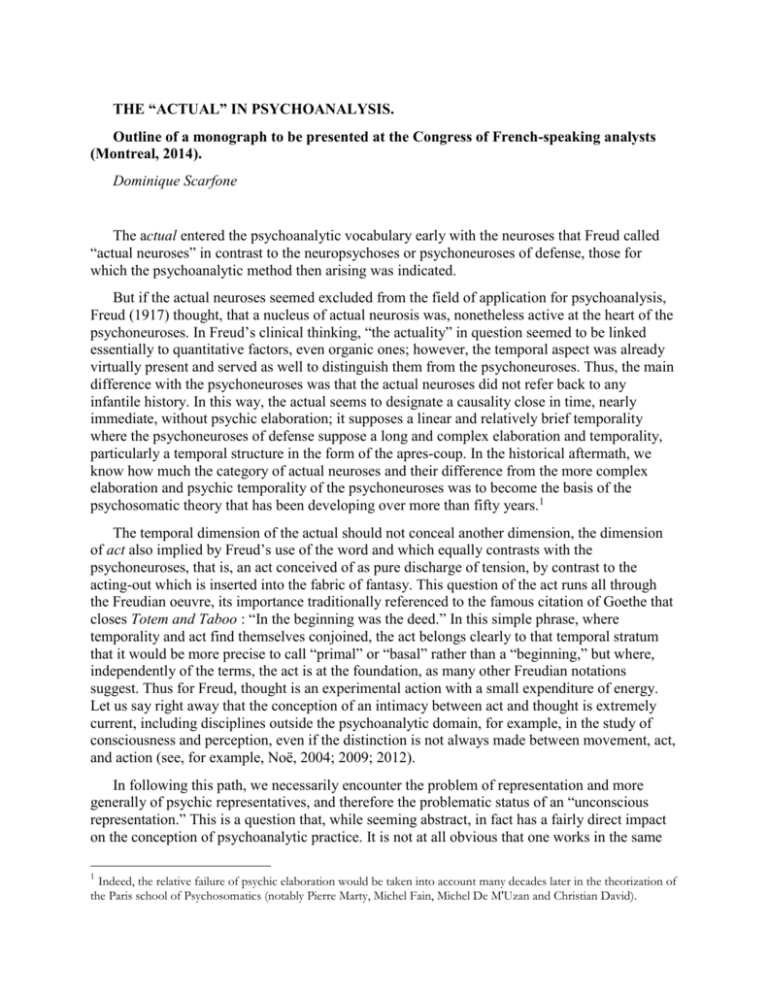
THE “ACTUAL” IN PSYCHOANALYSIS. Outline of a monograph to be presented at the Congress of French-speaking analysts (Montreal, 2014). Dominique Scarfone The actual entered the psychoanalytic vocabulary early with the neuroses that Freud called “actual neuroses” in contrast to the neuropsychoses or psychoneuroses of defense, those for which the psychoanalytic method then arising was indicated. But if the actual neuroses seemed excluded from the field of application for psychoanalysis, Freud (1917) thought, that a nucleus of actual neurosis was, nonetheless active at the heart of the psychoneuroses. In Freud’s clinical thinking, “the actuality” in question seemed to be linked essentially to quantitative factors, even organic ones; however, the temporal aspect was already virtually present and served as well to distinguish them from the psychoneuroses. Thus, the main difference with the psychoneuroses was that the actual neuroses did not refer back to any infantile history. In this way, the actual seems to designate a causality close in time, nearly immediate, without psychic elaboration; it supposes a linear and relatively brief temporality where the psychoneuroses of defense suppose a long and complex elaboration and temporality, particularly a temporal structure in the form of the apres-coup. In the historical aftermath, we know how much the category of actual neuroses and their difference from the more complex elaboration and psychic temporality of the psychoneuroses was to become the basis of the psychosomatic theory that has been developing over more than fifty years.1 The temporal dimension of the actual should not conceal another dimension, the dimension of act also implied by Freud’s use of the word and which equally contrasts with the psychoneuroses, that is, an act conceived of as pure discharge of tension, by contrast to the acting-out which is inserted into the fabric of fantasy. This question of the act runs all through the Freudian oeuvre, its importance traditionally referenced to the famous citation of Goethe that closes Totem and Taboo : “In the beginning was the deed.” In this simple phrase, where temporality and act find themselves conjoined, the act belongs clearly to that temporal stratum that it would be more precise to call “primal” or “basal” rather than a “beginning,” but where, independently of the terms, the act is at the foundation, as many other Freudian notations suggest. Thus for Freud, thought is an experimental action with a small expenditure of energy. Let us say right away that the conception of an intimacy between act and thought is extremely current, including disciplines outside the psychoanalytic domain, for example, in the study of consciousness and perception, even if the distinction is not always made between movement, act, and action (see, for example, Noë, 2004; 2009; 2012). In following this path, we necessarily encounter the problem of representation and more generally of psychic representatives, and therefore the problematic status of an “unconscious representation.” This is a question that, while seeming abstract, in fact has a fairly direct impact on the conception of psychoanalytic practice. It is not at all obvious that one works in the same 1 Indeed, the relative failure of psychic elaboration would be taken into account many decades later in the theorization of the Paris school of Psychosomatics (notably Pierre Marty, Michel Fain, Michel De M'Uzan and Christian David). manner when one considers what happens in the course of analytic session as resulting from a representation—i.e. an internal replica of the external world—, or, to the contrary, as manifesting itself as something actual—in the double sense of presence and of act (Kahn, 2012). In the latter case, temporality does not refer to a constituted past, but to a force currently active, although inaccessible, corresponding to that which has precisely not yet been “put into the past tense” (Winnicott, 1964). I will therefore advance the idea that rather than working on the past, psychoanalysis works on an “impassé,” an “unpast,” that is to say, a time marked by an impasse and which brings repetition in place of the elaboration characteristic of psychic life (Scarfone, 2006; 2012a). This « unpast » would be one of the forms taken by “actual” time, understood in the sense of “a time which does not pass” (Pontalis, 1997). Its dimension of presentation, inseparable from its actuality, solicits an ethical stance different from that resulting from a practice based on representation. Indeed, the Ethics based on presentation is our Epistemics as well, providing an essential tool for knowledge, since no human fact lets itself be known in a useable manner in analysis without the mediation of an availability, a capacity of the analyst to let him- or herself be affected by something like an actual presence. A presence whose effectiveness (Wirklichkeit) excludes any “metaphysics of presence,” as it engages at once an inherent absence, already suggested by Freud in the Project for a Scientific Psychology (Freud, 1895) when he discerned at the heart of the familiar other, a thing (Ding), escaping comprehension. The thing appears as a hollow at the very heart of the actuality of presence. By its very resistance to be grasped in the immediacy of perception, the thing offers a space for language and the attempt to put it into words, thereby fabricating a temporal structure, eventually engendering a diachrony. From this point we can see other questions emerging, like that of how to articulate a metapsychology founded on absence and the lost and distant (fort) object—and the separation anxiety and loss of enjoyment of the object that ensue—, with, on the other hand, a metapsychology taking into account the dimension of presence (da). The latter has a double impact, with presence being a source of anxiety in face of the unfamiliar, but, simultaneously, offering the sole possibility for the creation of connections, along the complex meandering of psychic differentiation. Connections in which the ethical stance is again given its primacy, being connections with an Other who, due to the opacity of the thing, is acknowledged as impossible to “totalize”, since aiming at total comprehensibility would signify a will to dominate this Other (Levinas, 1971, 1992)—a pressure contrary to the psychoanalytic project. By extension, while it is generally admitted that transference has to do with a putting into act rather than a staging, working analytically on such premise is not always an obvious or easy matter. It is difficult indeed to detach oneself from an ego-centered point of view where an “internal narrator,” i.e. the Ego, thinks itself the subject of action, whereas unconscious processes rather signal the primacy of the Other. A primacy, it must be said, where the Other is not an “other center” but rather entails a radical de-centering (Laplanche, 1992). To such de-centering the Ego unceasingly reacts, seeking to bring itself to a repose and, by the same token, to constantly reposition itself as a center. But is not analysis itself called upon, against common sense, precisely to move the ground on which the Ego wishes to anchor this center, pushing the subject not towards some state of bliss, but rather towards a state of “permanent uneasiness,” (de M’Uzan, 2011) which is life itself ? This conception of de-centering is a third way in relation to the “either/or” that seems proposed nowadays to psychoanalysts: either “classical solipsism” and a staunch separation between analyst and analysand or an “intersubjectivity” where analyst and 2 analysand are on an equal footing within a perfectly symmetrical relationship. The latter is apparently conceived of as a relationship resting on a dialogue between two subjects so “wellcentered” that the empathy of one (the analyst) would envelope the other (the patient) in curative benevolence. This would be a far cry from the “foreign body” that is literally the unconscious. In many instances, this “new intersubjective” way of doing analysis makes reference to nonneurotic problematics as a reason for dismissing the analytic method founded on “classical” metapsychology, all the more so as the term “classical” is meant to summon up the stereotypical image of the omniscient analyst who keeps him/herself at a cold distance from the analysand. But reflecting on the “actual” raises an alternative proposition: what exactly is the analysand (“neurotic” or “borderline” as he may be) putting into act in the analytic session? And does this putting into act suppose a subject already formed or, on the contrary, is not subjectivity a result, a culmination of the act, by way of its treatment by the analytic couple ? Subjectivity can indeed be thought of as stemming from the basal, primal stratum of the “actual”, a stratum that analysis is called upon to rejoin in proceeding methodically, although it can only be reached in “moments of grace”—rare by definition—that the analytic method ideally favors, without the analyst being able to plan or predict them (Scarfone, 2012a,b). In my monograph, I plan to explore more in depth these questions which inevitably resonate with other dimensions of analytic treatment. To explore, for example, what flows from a conception of analytic technique that involves a “putting into presence” in the analytic setting. A putting into presence that sends us back not to the symmetrical relationship mentioned above nor to any technique of the here-and-now that would be cut off from reference to a history. The “actual”, then, is not the negation of a personal history, but a matrix from which both the dimension of the past and the possibility of a becoming may arise through the—itself actual— work of analysis. Nor is the history thus created a more or less well documented self-narrative, but rather an active current in the life of the subject. This is a current by which the patient should be able, thanks to the work of the analysis, to let him or herself be traversed, so that whatever acts as a sterile repetition of the unpast may eventually be turned anew toward the future. Many other questions arise which concern the relationship of the actual to the sexual, to language, to the dream...work which, now that it has been announced, remains to be actualized... D.S. August 2012 (Translated by Lewis Kirshner with the participation of Allannah Furlong. My gratitude to both.) References Freud, Sigmund (1894) “The neuro-psychoses of defence”, Standard Edition, Volume III, The Hogarth Press, 1962. — (1895) “Project for a scientific psychology”, i Standard Edition, Volume I, The Hogarth Press, 1966. 3 — (1896) “Further remarks in the neuro-psychoses of defence”, Standard Edition, Volume III, The Hogarth Press, 1962. — (1917) “Introductory Lectures to psycho-analysis”, Standard Edition, Volume XVI, The Hogarth Press, 1962 Kahn, Laurence (2012) L’écoute de l’analyste, Paris, PUF, « Le fil rouge ». Laplanche, Jean (1992) “The Unfinished Copernican Revolution”, in Essays on Otherness, London and New York, Routledge, 1999. Levinas, Emmanuel (1971) Totalité et infini. Essai sur l’extériorité. Le livre de poche, coll. Biblio-essais. — (1992) Éthique comme philosophie première, Paris, Rivages poche. M’Uzan, Michel de, (2011) « Reconsidérations et nouveaux développements », in Nouveaux développements en psychanalyse. Autour de la pensée de Michel de M’Uzan (Clarisse Baruch, Editor), Paris, EDK Éditions, Coll. « Pluriel de la psyché ». Forthcoming in English as “Reconsiderations and new developments in psychoanalysis”, in Identity and Death, London, Karnac Books. Noë, Alva (2004) Action in Perception, Cambridge, MIT Press. — (2009), Out of our Heads: Why You Are Not Your Brain and Other Lessons from the Biology of Consciousness, New York, Hill and Wang. — 2012, Varieties of Presence, Cambridge, Harvard University Press. Pontalis, J.-B. (1997) Ce temps qui ne passe pas, Paris, Gallimard, Coll. « Tracés ». Scarfone, Dominique (2006) “A Matter of Time: Actual Time and the Production of the Past”, Psychoanalytic Quarterly, LXXV, 807-834. — (2012a) « Moments de grâce: Présence et élaboration de “l’impassé” », in Michel de M’Uzan ou le saisissement créateur (sous la direction de Murielle Gagnebin et Julien Milly), Paris, Champ Vallon, coll. L’Or de l’Atalante. — (2012b) Quartiers aux rues sans nom, Paris, Éditions de l’Olivier, Coll. « penser/rêver ». Winnicott, Donald Woods, (1964), “Fear of Breakdown”, in Psychoanalytic Explorations, Cambridge, Harvard University Press, 1989. 4


